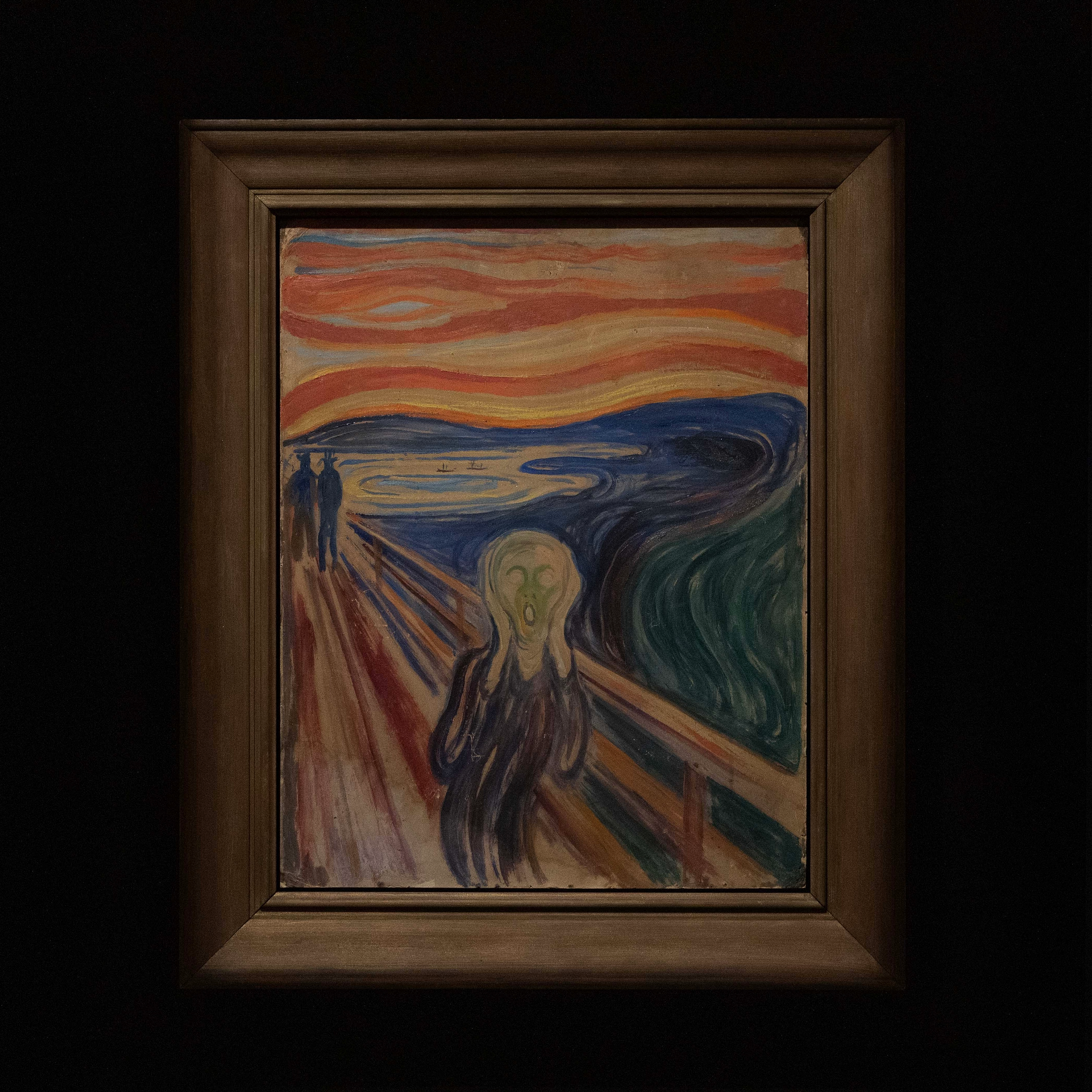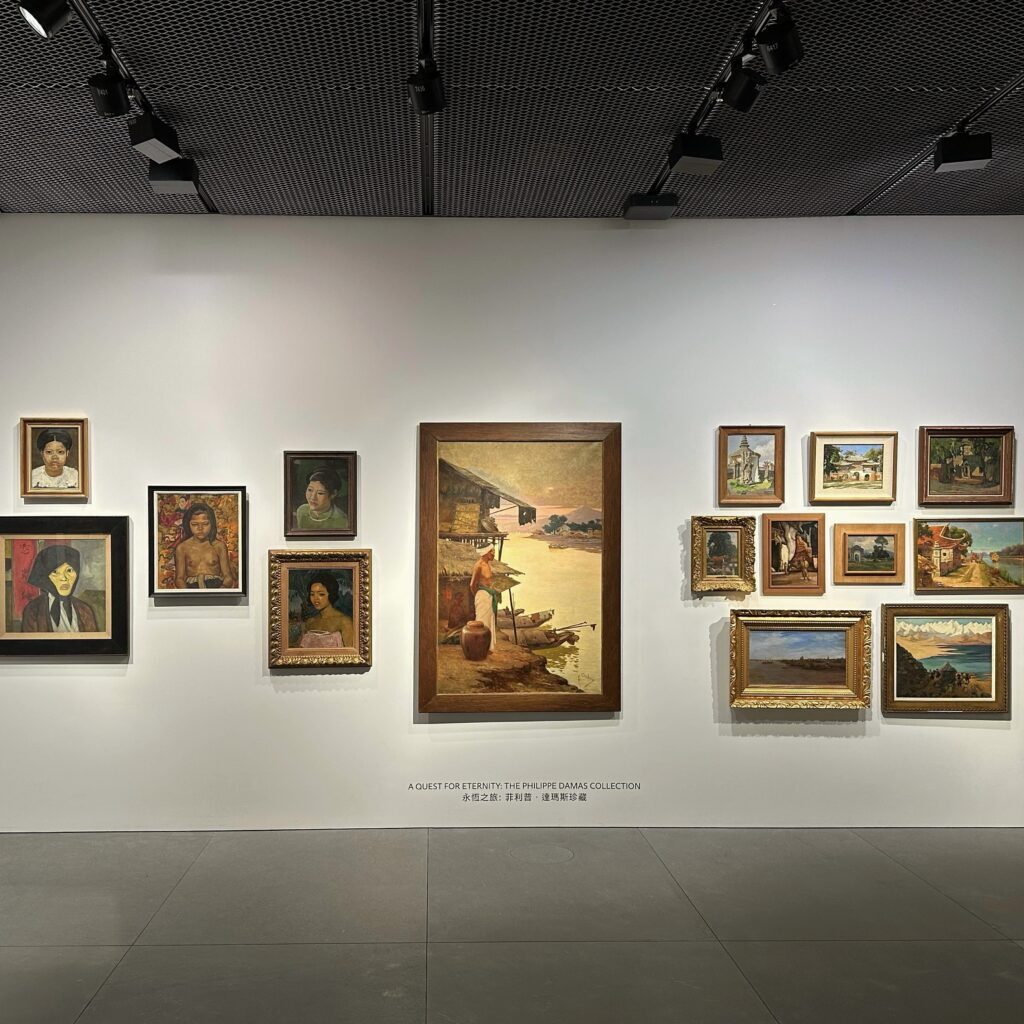
The Scream — One of the world’s most famous artworks, a universal symbol of anxiety and it even has its own emoji.
Edvard Munch (Norwegian, 1863-1944)
The Scream
unsigned
oil, tempera, pastel and crayon on cardboard
91 × 73.5 cm. (36 × 28.9 in.)
painted in 1910?
Collection of Munch Museum
Munch's challenge in this painting is to depict a deafening scream through the silent art of painting.
The face, with its mouth torn open by a scream, seems to writhe in anguish.
And yet, if it wasn't the figure screaming. What if, on the contrary, he were plugging his ears in an attempt to drown out the dreadful noise?
But what noise? It's in his diary, dated January 22, 1892, that the Norwegian painter seems to give us the key to this painting.
"I was walking along a path with two friends - the sun was setting - and suddenly the sky turned blood-red. I stopped, tired, and leaned on a fence - there was blood and tongues of fire over the city's blue-black fjord - my friends went on, and I stayed there, trembling with anxiety - I felt an infinite scream passing through the universe and tearing nature apart".
Munch's cry is therefore external to the character. And indeed, look how the landscape seems to vibrate under the effect of his sinuous brushstrokes.
A terrible scream, a blood-red sky: is Munch the victim of an anxiety attack? It has to be said that the painter, battered by life since childhood (he lost his mother and sister to tuberculosis), was often plagued by depression.
However, American astrophysicists have put forward an entirely different hypothesis: on August 27, 1883, the Krakavoa volcano erupted in Indonesia. The sound of the eruption could be heard 4,800 kilometers away, and volcanic ash invaded the atmosphere as far away as Northern Europe.
Well, that would explain the strangeness of the landscape, but you have to admit that the character has a peculiar face too. But then again, it would seem that he's not just the product of a tortured soul. In 1889, at the Paris World's Fair, Munch saw a Peruvian mummy. Curled up, it holds its head in its hands and its mouth appears distorted by a scream. This mummy of a young man, probably the victim of pneumonia, crystallized all Munch's anxieties about death, and had such an effect on the painter that he drew inspiration from its position as much as from the color of its skin when creating the central figure of The Scream.
When the painting was published, there was no shortage of detractors. The version in Norway's Nasjonalmuseet even bears a strange note: "Can only have been painted by a madman". Who dared desecrate the work of the master of Expressionism in this way? Analyses have revealed that this phrase was written... by Munch himself. A nice way to warn and mock the critics!

Munch created four versions — two paintings with tempera, and two drawings with pastel and crayon.
The first painted version was first exhibited, debuting in 1893. It is in the collection of the National Gallery of Norway in Oslo. This is the version that has the barely visible pencil inscription "Kan kun være malet af en gal Mand!" ("could only have been painted by a madman").
A pastel version, which may have been a preliminary study, is in the collection of the Munch Museum, also in Oslo.
The second pastel version, from 1895, was owned by the German Jewish art collector Hugo Simon who sold it to Norwegian ship owner Thomas Olsen "around 1937". It fetched $119,922,600 at Sotheby's Impressionist and Modern Art auction on 2 May 2012 to American businessman Leon Black, becoming the world’s most expensive work of art ever to sell at auction over the course of a nearly 15-minute bidding war, compared to the old auction record held by Picasso’s “Nude, Green Leaves and Bust,” which sold for $106,500,000 at Christie’s 2 years ago.
The second painted version dates from 1910, during a period when Munch revisited some of his prior compositions. It is also in the collection of the Munch Museum. These versions have seldom travelled, though the 1895 pastel was exhibited at the Museum of Modern Art in New York from October 2012 to April 2013, and the 1893 pastel was exhibited at the Van Gogh Museum in Amsterdam in 2015.
Edvard Munch (Norwegian, 1863-1944), the son of Christian Munch, a military doctor, and his wife Laura, spent his childhood in Oslo (formerly Kristiania). His mother died from tuberculosis when he was five years old. Having to stay in bed for whole winters due to delicate health as a child, Edvard could not attend school and was taught at home instead. Overshadowing by illness, bereavement and dread of inheriting a mental condition that ran in the family gave him strength and the freedom to nurture and pursue his passion for art by drawing. In 1880, he enrolled and was admitted to the Royal School of Art and Design, where he met his first mentor and supporter, the renowned naturalistic painter Christian Krohg, and his talents were awakened since then.
At the age of 22, thanks to a scholarship, he, for the first time, travelled to Paris, somewhere bigger beyond Norway opened up to him. He spent his mornings at Bonnat’s studio and afternoons at the exhibitions, galleries, and museums. Munch was enthralled and inspired by the vast display of modern European art, including the works of three artists who would prove influential: Paul Gauguin, Vincent van Gogh, and Henri de Toulouse-Lautrec — all notable for how they used colour to convey emotion. In November 1889, his father suffered a stroke and passed away. He was devastated.
In 1892, Adelsteen Normann, on behalf of the Union of Berlin Artists, invited Munch to exhibit his works at its November exhibition. His art evoked bitter controversy and shocked the German public, and after one week, it was closed. Pleased with the ‘great commotion’, he wrote in a letter “Never have I had such an amusing time—it's incredible that something as innocent as painting should have created such a stir." A solo show in Berlin in 1892 was noisily shut down by a conservative art faction, giving him, as he was delighted to note, invaluable publicity. To make the most of the “Munch affair,” as it was called, he settled in the city and stayed for nearly 16 years. Some of his best-known images originated during this time: “Madonna,” “Puberty,” and “The Scream.” Munch became involved in an international circle of writers, artists and critics during the time he was in German, including the Swedish writer and artist August Strindberg, whom he painted, as he embarked on a major series of paintings he would later call The Frieze of Life, depicting a series of deeply-felt themes such as love, anxiety, jealousy and betrayal, steeped in atmosphere.
As his fame and wealth grew, his emotional state remained insecure. He briefly considered marriage, but could not commit himself. A mental breakdown in 1908 forced him to give up heavy drinking, and he was cheered by his increasing acceptance by the people of Kristiania and exposure to the city's museums. His later years were spent working in peace and privacy. Although his works were banned in Nazi-occupied Europe, most of them survived World War II, securing him, one of Modernism's most significant artists, a legacy.











